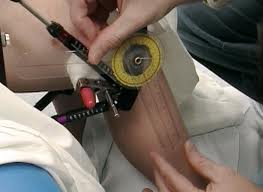The hip
is one of the body's largest joints. It is a ball-and-socket joint.
The socket is formed by the acetabulum, which is part of the large
pelvis bone. The ball is the femoral head, which is the upper end of
the femur (thighbone).
The
most common cause of chronic hip pain and disability is arthritis.
Osteoarthritis, rheumatoid arthritis, and traumatic arthritis are the
most common forms of this disease.
Osteoarthritis.
Rheumatoid
arthritis.
Post-traumatic
arthritis.
Avascular
necrosis
Childhood
hip disease.
Hip replacement surgery is a procedure in which a doctor surgically
removes a painful hip joint with arthritis and replaces it with an
artificial joint often made from metal and plastic components. It
usually is done when all other treatment options have failed to
provide adequate pain relief. The procedure should relieve a painful
hip joint, making walking easier.A total hip replacement is a
surgical procedure whereby the diseased cartilage and bone of the hip
joint is surgically replaced with artificial materials
Candidates
for Surgery
There
are several reasons why your doctor may recommend hip replacement
surgery. People who benefit from hip replacement surgery often have:
• hip pains that limits everyday activities, such as walking or bending
• hip pains that continues while resting, either day or night
• Stiffness
in a hip that limits the ability to move or lift the leg
• Inadequate
pain relief from anti-inflammatory drugs, physical therapy, or
walking supports
• There
are no absolute age or weight restrictions for total hipreplacements.
Recommendations
for surgery are based on a patient's pain and disability, not age.
Most patients who undergo total hip replacement are age 50 to 80, but
orthopaedic surgeons evaluate patients individually. Total hip
replacements have been performed successfully at all ages, from
the young teenager with juvenile arthritis to the elderly patient
with degenerative arthritis.
During
standard hip replacement surgery, you are given general anesthesia to
relax your muscles and put you into a temporary deep sleep. This will
prevent you from feeling any pain during the surgery or have any
awareness of the procedure. A spinal anesthetic may be given to help
prevent pain as an alternative.
The
doctor will then make a cut along the side of the hip and move the
muscles connected to the top of the thighbone to expose the hip
joint. Next, the ball portion of the joint is removed by cutting the
thighbone with a saw. Then an artificial joint is attached to the
thighbone using either cement or a special material that allows the
remaining bone to attach to the new joint.
The
doctor then prepares the surface of the hipbone -- removing any
damaged cartilage -- and attaches the replacement socket part to the
hipbone. The new ball part of the thighbone is then inserted into the
socket part of the hip. A drain may be put in to help drain any
fluid. The doctor then reattaches the muscles and closes the
incision.
While
most hip replacement surgeries today are performed using the standard
technique (one 8 to 10 inch cut along the side of the hip), in recent
years, some doctors have been using a minimally-invasive technique.
In the minimally-invasive approach, doctors make one to two cuts from
2 to 5 inches long. The same procedure is performed through these
small cuts as with standard hip replacement surgery.
Infection
Infection
may occur superficially in the wound or deep around the prosthesis.
It may happen while in the hospital or after you go home. It may even
occur years later.
Blood
Clots
Blood
clots may form in the leg veins or pelvis.
Blood
clots in the leg veins or pelvis are the most common complication of
hip replacement surgery.
Leg-length Inequality
Sometimes
after a hip replacement, one leg may feel longer or shorter than the
other
Loosening and Implant Wear
Over
years, the hip prosthesis may wear out or loosen. This is most often
due to everyday activity. It can also result from a biologic thinning
of the bone called osteolysis. If loosening is painful, a second
surgery called a revision may be necessary.
You will likely stay in the hospital for four to six days and may have to stay in bed with a wedge-shaped cushion between your legs to keep the new hip joint in place. A drainage tube will likely be placed in your bladder to help you go to the bathroom.Physical therapy usually begins the day after surgery and within days you can walk with a walker, crutches, or a cane. You will continue physical therapy for weeks to months following the surgery.
Hip Replacement Surgery can be best done in Orthopedics India at low cost by India's top hip surgeon Dr. S.V. Santpure M.S. Sure your appointment through by filling enquiry form www.orthopedicsindia.com






